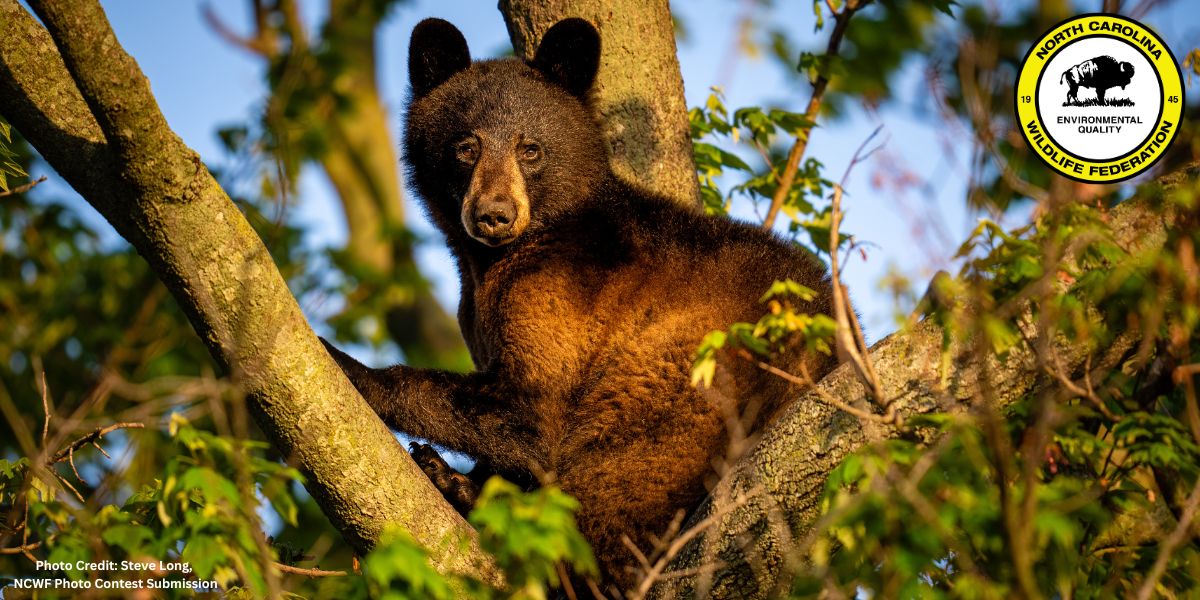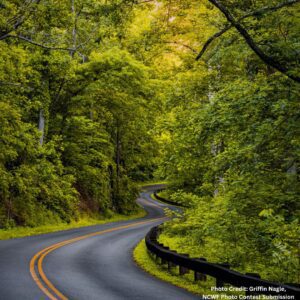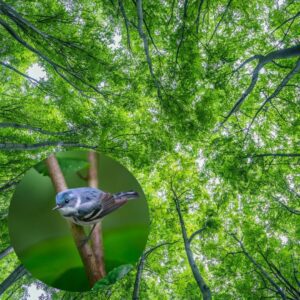Wildlife in the Overstory: North Carolina Species in the Treetops


In April, 2024 , we explored Wildlife in the Overstory.
Throughout history, we have depended on the natural world for sustenance, shelter, and resources essential for our survival. Yet, this dependence has often come at a cost, as our philosophy of dominance has led to the exploitation of natural resources – including large-scale environmental degradation and loss of biodiversity.
Our interactions and impact on trees exemplify this often tense relationship. Their practical uses are undeniable; we adorn our yards with trees of various types. We fell them for wood to construct homes, provide warmth, and craft furniture. We harvest their fruits, nuts, and seeds for food.
Yet, beyond their material benefits, we often forget the invaluable environmental services they provide. They shade us, and support our crops, waterways, and other natural landscapes – shielding fragile and temperate landscapes from the heat of the sun. Moreover, they draw in and sequester carbon, mitigating the impact of our relentless emissions into the atmosphere. Alongside photosynthesizing algae (which produces 70% of atmospheric oxygen), trees convert carbon into oxygen essential for our survival.
Setting aside human utility, trees play an essential role not only for us but for countless other forms of life on earth. You can see this in action by simply stepping outside, looking up and observing the wildlife overhead that often evades our attention… those that depend upon tree canopy habitat: the wildlife in the overstory.
While there is a multitude of wildlife species observable at ground level, many rely on the shelter and resources provided by trees, particularly those thriving in their canopies. These tree canopies can create an entirely distinct habitat for wildlife, many of which have evolved and adapted to depend upon them. However, these habitats – and the wildlife within them – face increasing threats from deforestation and habitat fragmentation, much of which results from human development and changes in land use.
While nearly every terrestrial wildlife species has some level of dependence on trees, certain species rely on them more heavily than others. In this blog, we shed light on some of the wildlife species that utilize trees for shelter, sustenance, sanctuary, and safe passage.
Canopy Connections: Risks to Overstory Wildlife Habitat
Despite their critical significance, trees face immense pressure from rapid deforestation for land use and development. Other factors include  pollution, erosion, and overall habitat degradation. Unfortunately, the harm inflicted on trees directly impacts wildlife, as well.
pollution, erosion, and overall habitat degradation. Unfortunately, the harm inflicted on trees directly impacts wildlife, as well.
Shelter:
Trees offer nesting and roosting habitat for various wildlife species across different habitats. Especially for prey species, these locations provide a crucial buffer from ground-based predators and other threats, whether nestled within branches or sheltered within trunk cavities.
Sanctuary:
Predation is a natural process vital to ecosystem health, yet for this balance to be maintained, prey species require adequate sanctuary. Trees serve as essential shelters for prey, while also offering some predators vantage points for hunting.
Sustenance:
Furthermore, trees sustain a wide array of wildlife species by providing food—from leaf-eating caterpillars to nut-gathering squirrels, berry-eating birds, and wood-consuming beetles.
Safe Passage:
 When observed from below, the tree canopy may appear to be a tangled, homogenous mix of leaves and branches. However, there is a pattern and system to the interconnected habitat above, which often function as highways for wildlife.
When observed from below, the tree canopy may appear to be a tangled, homogenous mix of leaves and branches. However, there is a pattern and system to the interconnected habitat above, which often function as highways for wildlife.
Trees serve as crucial travel corridors for a variety of terrestrial wildlife, including species of mammals, reptiles, amphibians, and birds. For instance, squirrels may utilize tree canopies to cross over impassable water bodies or roadways, while birds utilize the tree cover as safe pathways for movement among forest systems.
This presents both advantages and challenges within artificially fragmented landscapes. While trees facilitate wildlife passage over natural features like waterways and manmade structures such as roads, the situation is nuanced. Returning to the squirrel example, endangered and nocturnal Carolina northern flying squirrels (Glaucomys sabrinus), for example, must glide across roadways to navigate their fragmented habitat range, exposing them to the peril of fast-moving vehicles in the dark.
But squirrels and roads are merely one example of the dangers posed by habitat fragmentation – and in some places, the removal of entire tree canopy habitats. When considering the impact that these habitat changes have on wildlife, all members of the ecosystem must be represented and evaluated.
Mammals in the Overstory
 When considering mammals that utilize the tree canopy in North Carolina, several species may instantly spring to mind.
When considering mammals that utilize the tree canopy in North Carolina, several species may instantly spring to mind.
Squirrels are easily identifiable and are commonly seen wildlife species across the state that rely on trees as a connection between understory (ground) and overstory (tree canopy). North Carolina is home to five squirrel species that utilize the ecosystem services offered by trees: gray squirrels (Sciurus carolinensis), red squirrels (Sciurus vulgaris), fox squirrels (Sciurus niger), Carolina northern flying squirrels (Glaucomys sabrinus) and southern flying squirrels (Glaucomys volans).
Squirrels utilize tree canopies and cavities for nesting, where they can safely bear and nurture their young. Additionally, they exploit treetops as a food source, foraging on nuts, seeds, berries, and tree buds, and they employ the canopy as a secondary mode of travel. As small prey animals, traversing the ground exposes them to numerous predators such as coyotes, foxes, bobcats, birds of prey, and domestic cats and dogs.

A northern yellow bat hanging from a dead palm frond, and its Spanish moss habitat.
Though not as adept at maneuvering among branches, raccoons and opossums too are mammals that seek refuge in trees to evade dangers on the forest floor and nest in tree cavities. Though they require larger nesting cavities than squirrels, these can be naturally formed in some trees and formed through the collaborative – though unintentional – efforts of woodpeckers and fungus.
The largest mammal in North Carolina to utilize the tree canopy is the black bear. Black bears are highly skilled climbers and typically opt to retreat to the safety of trees rather than confront threats.
Bats are another mammalian species reliant on trees, although tree site preferences vary among species. While some bat species occupy tree cavities for roosting, others prefer caves or manmade structures. However, certain species, such as the northern yellow bat (Lasiurus intermedius) and the Seminole bat (Lasiurus seminolus), favor the hanging foliage of treetops. While northern yellow bats are most attracted to dead palm fronds for nesting, both northern yellow bats and Seminole bats seek refuge in draping clumps of Spanish moss. This moss provides insulation and protection from the elements, but does influence the distribution range of these bats – as Spanish moss is generally confined to the southeastern United States.
Birds in the Overstory

The cerulean warbler (a species of greatest conservation need) depends upon overstory habitat for nesting and foraging.
In most places, it’s tough to envision gazing up into a tree canopy without spotting birds flitting between branches. This makes birds one of the wildlife types most easily connected with trees and the overstory.
However, certain bird species rely on tree habitats more heavily than others, with unique needs and resources fulfilled by trees across species.
Many bird species construct nests in tree branches, but some prefer their nests to be situated as high up in the canopy as possible. Certain warblers, like the cerulean warbler (Setophaga cerulea), opt for nesting at the highest point in the canopy, conducting the majority of their foraging within the overstory. Many coastal bird species also favor elevated nesting sites, such as the swallow-tailed kite (Elanoides forficatus), which selects the tallest trees within their preferred wetland habitats.
Some bird species nest on the ground but roost in tree tops overnight – such as turkeys and ruffed grouse. Grouse typically roost in branches

closer to the ground, while turkeys often favor roosting spots in the largest oaks or pines within their vicinity. Roosting in trees offers these birds protection from nocturnal predators, a trait turkeys develop as early as 14 days old.
Some birds opt to nest within tree trunks. Among the cavity-nesting birds are various types of owls, chickadees, nuthatches, woodpeckers, wood ducks, select warblers, bluebirds, and more. Unlike many bird species that can nest in a variety of locations within the tree canopy, cavity nesters rely on this limited niche of naturally occurring or wildlife-created cavities – which often necessitates trees that are either dead or in decline. Around urban and suburban areas, the tendency to cut trees down as soon as they show signs of death or sickness makes it increasingly difficult for these cavity nesters to find safe nesting sites.
As one of the only bird species (in addition to chickadees and nuthatches) capable of excavating their own nesting cavities, abandoned woodpecker holes provide nesting habitat for various bird species and even other creatures such as squirrels and certain nest-building insect species.
Amphibians in the Overstory
 Amphibians are often wildlife species that, to varying degrees, inhabit both aquatic and terrestrial environments at different stages of their life cycles. For certain amphibious creatures, treetops are included as an important part of their terrestrial habitat.
Amphibians are often wildlife species that, to varying degrees, inhabit both aquatic and terrestrial environments at different stages of their life cycles. For certain amphibious creatures, treetops are included as an important part of their terrestrial habitat.
Treefrogs have specialized fingers containing tube-like bristles and a layer of mucus that enables them to swiftly ascend tree trunks and adhere to leaf surfaces. This adaptation serves as an effective escape mechanism from predators and grants them access to a diversity of insect species inhabiting the tree canopy.
Interestingly, some salamanders, like the Hickory Nut Gorge green salamander (Aneides caryaensis), exhibit arboreal behavior, allowing them to climb trees like their treefrog counterparts. The Hickory Nut Gorge salamander is largely nocturnal and spends much of its time atop rock outcroppings and tree canopies, preying on insects that live in these elevated habitats.
Insects in the Overstory
 Many species of insects also rely on treetop habitats and resources. Wasps and hornets construct nests on overhanging branches and within tree cavities, at a safe distance from most ground predators.
Many species of insects also rely on treetop habitats and resources. Wasps and hornets construct nests on overhanging branches and within tree cavities, at a safe distance from most ground predators.
Caterpillars, beetles, and aphids also find refuge in the canopy, alongside pollinators that frequent the blossoms atop the upper reaches of the overstory, often hidden from view.
The early larval stages of butterflies and moths often emerge in nests within treetops, as well. You might have noticed dense clusters of spiderweb-like fibers in treetops. These nests of webs belong to several species of caterpillars, such as the fall webworm and eastern tent caterpillar.
Some species – such as cicadas – depend upon tree habitats for all stages of their life cycle, from reproducing in the treetops to sucking the sap from tree roots as nymphs.
Reptiles in the Overstory
 Few reptiles in North Carolina frequent the highest tree tops, but several do rely on the area between the understory and the overstory.
Few reptiles in North Carolina frequent the highest tree tops, but several do rely on the area between the understory and the overstory.
Both green anoles and Eastern fence lizards ascend tree trunks to forage, evade predators, and bask in the sun’s warmth. Eastern fence lizards (Sceloporus undulatus) boast specialized adaptations for blending into tree bark, while green anoles (Anolis carolinensis) possess the ability to adjust their coloration to match their surroundings.
Although many possess the capability, most snakes in North Carolina tend to avoid tree climbing. Rat snakes (Pantherophis obsoletus) and rough green snakes (Opheodrys aestivus), however, defy this trend. This is particularly common in wetland areas with water covering the ground, and areas with thick undergrowth where snakes need to get higher to hunt for prey such as songbirds, insects, and smaller reptiles and amphibians.
Want to learn more about Wildlife in the Overstory?
Written by:

– Bates Whitaker, NCWF Communications & Marketing Manager

– Dr. Liz Rutledge, NCWF Director of Wildlife Resources


